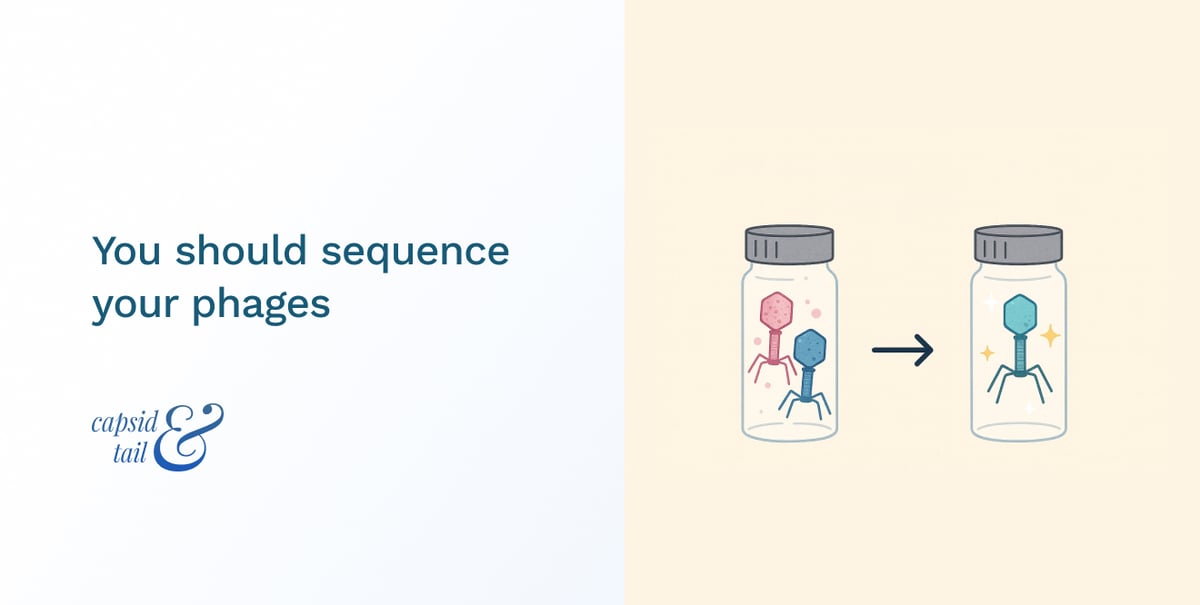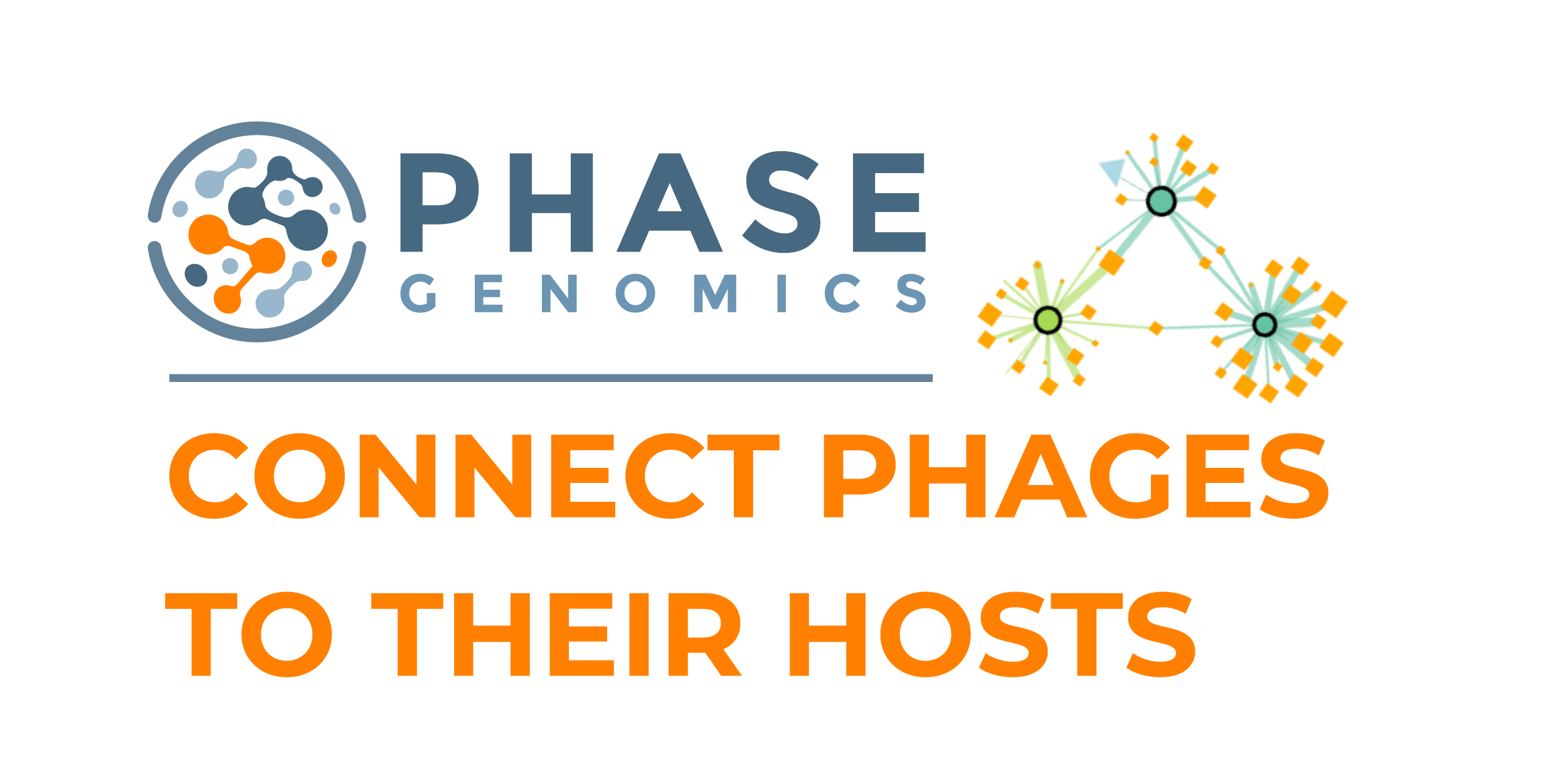The ones in your fridge that you’re using right now.
But I got them from a reputable lab…
You should sequence your phages — the ones in your fridge that you’re using right now. Word on the street is 12/13 academic labs have mixed phage stocks. Even the most reputable phage labs we’ve all heard of.
But I already sequenced them…
You should sequence your phages — the ones in your fridge that you’re using right now. Phages drift — that’s what they do! You might find that your phage isn’t the same phage as it once was.
But I am careful and I wouldn’t have contaminated them…
You should sequence your phages — the ones in your fridge that you’re using right now. Phages often look like other phages. And they like to hang out in the air and on pipettes and in the nozzle on your vacuum filter that you use to filter sterilize your phages.
But I bought them from a culture collection…
You should sequence your phages — the ones in your fridge that you’re using right now. Culture collections are not perfect either, and even if they sequenced them at one time, sequencing doesn’t always pick up low-level contaminants. One propagation could be enough for that low-level phage to become a majority member of the lysate.
But I’ve kept my phages in the freezer at -80 with glycerol and they literally haven’t been touched since the last time they were opened, and right before we stored them like that, we sequenced them and proved they were clean!
Ok, you’re probably good.
It’s time to stop trusting our phage stocks (or at least: trust, then verify)
It’s time for the phage field to sequence our phages, and get in the habit of resequencing them before we use them in important experiments. Plasmidsaurus exists as a plasmid resequencing service. So does Addgene, in essence. The plasmid people figured this out and they sequence their plasmids before trusting them. Now people buy fresh plasmid stocks from Addgene whenever they have doubts or want to start something new. It saves much more money than it costs.
So why aren’t we doing this with our phages, which are basically plasmids?
But it’s expensive…
It’s less expensive than realizing years of work on a phage was actually years of work on a different phage, or two phages masquerading as one, or that every time you did an experiment it was a slightly different version of this mystery cocktail, and thus you can’t really interpret your data.
And it’s actually not that expensive anymore — it should cost $100 per sample if you submit through Illumina. Plasmidsaurus can sequence them this way - so can many services. These are ubiquitous in most places now.
But it’s hard to get DNA from phages
If you use Illumina you will not need a lot. Plasmidsaurus asks for 20 ul of 10 ng/ul if you use Illumina through them (I used to think they only did long-read, which requires way more DNA, but just learned they also do short read!). Daria Van Tyne’s lab extracts DNA from 250 ul of lysate and it is enough for Illumina. If you use tagmentation you can do it with less than 100 ul (see also here).
But my PI doesn’t want me to spend all my time on this, I have experiments to do
Your experiments will go much faster if you know what you’re actually working with.
But I’m afraid of what I might find…
“I might find out that my lab has been working with phages that aren’t the phages we think they are…”
“My paper came out in Nature and if I find out it wasn’t really those phages in the vials, what will I do?”
“My colleagues/peers/collaborators won’t take my lab seriously anymore.”
Yes, all valid fears. If it helps, I for one will celebrate you for being brave and checking anyway. You can handle whatever comes next — you’ll at least be armed with evidence. It might lead to even more cool discoveries/mysteries solved, or new projects spawned! (A giant chunk of my PhD was based around two very similar-but-not-the-same, spontaneously-varied phages, and why they had different phenotypes).
Let’s just check our phage stocks
Let’s just check our phage stocks. Check the one you’re using actively - just take a sample, extract DNA using any kit, and send it for illumina sequencing.
Use Geneious to assemble the reads and blast to find out what you have. You don’t need to be a bioinformatician. Ask ChatGPT to help you. Map them to the reference genome of the phage you think you have. And maybe map them to a few other phage genomes you work with in your lab.
You might be surprised. It might hurt. Your PI will probably be happy with you in the end, because you might resolve a years-long puzzle about why someone’s project’s results haven’t made sense, or haven’t replicated.
Or you might find your phage stocks are clean - you have 100% match with the phage you think you have. Brilliant! Please store this in glycerol at -80C (follow this paper by the Felix D’Herelle Center team), and make a bunch of aliquots of it in your fridge.
Start a basic spreadsheet: each phage batch gets a number and a location
Start a spreadsheet where you track BATCHES of phages, not NAMES of phages. You now have Phage Batch #1. You know what’s in there. You can confidently share it, do experiments on it, make more of it. You can now do this for all your lab’s phages. If you find a mixture, it’s okay. Just plate it for single plaques on a lawn, and pick each one with a toothpick — propagate from each of those. Now you have more phages than you thought you had! Sequence those ones and bank them once they’re pure.
Don’t get bogged down — just start somewhere
I’ll leave it here for now. Yes, there are many ways to sequence, to assemble reads, to annotate them, to extract DNA, to store phages, to do everything with phages. Just start with one way that gives you a sequence. You can tweak it later. At least you’ll have a window into what phage you have.
How often do I have to do this?
Ideally, every time you propagate your phage, you should check it in some way. However it doesn’t always have to be sequencing!
Easier/cheaper ways to check your phages
Once you have a sequence-confirmed clean stock, there are other ways of flagging cross-contamination more quickly and cheaply. You could establish a small host panel, where each of your phages has a known plaquing profile across them. Like phage A plaques on strain A, B, but not C. While phage B plaques on strain C but not A or B. This is a simple way to flag if you have A or B in your hands. Takes work but if you work with a small set of phages, you could take the time to choose this strain set, demonstrate to yourself that it works, and use it as a sanity check every time you make a new batch of phages. You can also design PCR primers against your phages and run PCR periodically to check that your phages are the same. Or you could do RFLP, where you digest the DNA with some restriction enzymes, and run it on a gel - then compare it to what it looked like the last time (or ideally, when you last sequenced it).
There are many ways to check a phage’s integrity. I am advocating that you do at least something. Or if you don’t, at least know that you might be among the 12/13 phage labs with mystery mixtures or phages masquerading as other phages. And if someone asks you for one of your phages, you might end up having to send it to them without having time to check what it is.
Reputable labs have mixed phages sometimes
It doesn’t make them less reputable — or at least, it really shouldn’t.
As a field, we didn’t always have cheap access to sequencing. We haven’t always known we needed to be this paranoid (and neither did the plasmid people!). We thought (fairly!) that a phage was a phage, and a tube labeled ‘T4’ was T4, and that was that.
And sequencing is still not THAT cheap. It takes time. And phage DNA is hard to get — DNA modifications can make it almost impossible. (FYI: try phi29 polymerase to pre-amplify phage DNA before sequencing if you struggle to get enough DNA from your phage! It will remove the modifications and also amplify the DNA).
But treating your phage stocks with a ‘trust but verify’ attitude — and establishing a freshly sequenced set of phage stocks for each phage you work on (and a process for routinely checking them as time goes on) — is worth the time and money. Think of all the experimental repeats and years-of-grad-student-project-misery that you will save in catching a mystery mixture before its phenotype is declared in a Nature paper, or before it gets mailed to your favourite collaborator.
I genuinely think anyone who works with phages will encounter phage mixtures once they start looking for them. And that’s okay — that’s just phages. But we now have the tools to see them, so we should use them.
I have worked in three phage labs in my life. In two out of three, we found unknown mixtures in our phage vials. In the other one, we never checked…
Acknowledgments
Thanks to Bob Blasdel for presenting on this idea (plus a ton of data!) at Phage Option Colombia last year (and I believe he will give another version of it this year at Evergreen!), and especially telling me about the ‘12/13 labs’ number… ask him about that if you see him!
Thanks to Daria Van Tyne and Jean-Paul Pirnay, who were kind about the unexpected phage mixtures they received from me/my past labs, who kindly sent the data so we could see for ourselves, and shared their favourite phage sequencing pipelines, methods and tips, which I now use (and will write about in the future!).
Cheers to being kind to your fellow phage lab, even if they send you a mixed or mislabeled phage sample!
What are your thoughts?
Does anyone want to add on to this conversation? Do you think I am being too paranoid? Do you want to share an anonymous (or non-anonymous) story of unidentified phage mixtures in your lab?
Or do you have a paper you follow for getting lots of phage DNA that you love? What’s your favourite way to analyze the reads? Do you have a pipeline you could share?
This article was my off-the-cuff rant, but I’d love to compile resources for phage labs looking to get a handle on their phage stocks, and I’d be THRILLED if someone wanted to write a guest post about their perspective on this matter!







